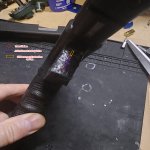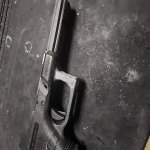You are using an out of date browser. It may not display this or other websites correctly.
You should upgrade or use an alternative browser.
You should upgrade or use an alternative browser.
Broken Glock Trigger Guard. Repair suggestions
- Thread starter _ox_
- Start date
Perhaps after the next election you will be able to get a factory replacement.
Haha, be surprised if they would warranty it now. I made the call to Frankenstein it and give up a possible warranty in lieu of having it useable again.
- Location
- Nova Scotia
I believe Slavex is the user you guys are discussing.
Yeah that's him.
- Location
- Blaster land, Okanagan BC
I'm also contemplating some JB Plastic Weld that I was reading about in one of the US forums. Will depend on how my melting tests go.
I’ve used it to repair holes in kombi Jerry cans that get punctures from chainsaw chains or dogs and it’s surprisingly tough, it bonds well to whatever you put it on as long as you clean/degrease it’s well and rough the surface up and give it some tooth to grab onto.
This is the two part stick that you kneed and mix together, gorilla glue makes a similar plastic epoxy I’ve used as well with equal results.
I believe Slavex is the user you guys are discussing.
Why not just say it then? Hard to forget a grown man that pretends he is a vampire or whatever.
PinaKaleada
CGN Regular
- Location
- South of most
Pics please!
Pics please!
Sure, I didn't take many as I should have, but here is the concept of what I did.
I drilled 2 1mm holes from the front, above and below the crack (Red Circles)
Then sutured it together with .032 aircraft safety wire twisting it to tighten it. Then melted the twisted end into the front of the trigger guard. (Purple Line)
Then melted a couple dimples on the break to help seal it together.
The slide removal lever retention spring was a little tight in there and didn't seat all the way back in, so it's got a little more pressure than stock. Probably could have trimmed 2mm off the bottom and been fine.

I tested the JB Plastic Bond and it worked amazingly to adhere to the frame, so I coated the repair in it and let it dry overnight. I've just sanded it and am going to repeat that process a couple times to make it look a little bit cosmetically better. Probably wont' go too crazy though and just be happy it's structurally solid. On the next coat I'm going to experiment using some clean sandpaper to texture it just before it hardens and see what that turns out like.

In hindsight, the JB Plastic Bond probably could have been used to just seal the break, but It's definitely isn't going to come apart now.
Plastics are so complex. The complexity is compounded more by the mere density of the plastics that Glocks are composed of using nylon 6 and it secret blend of this material that make this a rigid product. Glocks patent of this plastic is a guarded a secret which makes it harder to fix when it breaks. I have tried fixing poly carbon plastics and failed many times and the results are never the way I wanted it to be like. I feel for this original poster and having a handgun ban even sucks more. If it was a Sig P320 it would be no problem, just change out the frame as the FCU is pulled away from the gun. Again Glocks plastics are a N6, the Sigs plastics are a N66 with infused tungsten which makes repairing these types of plastics more difficult to repair in the future when an incident does happen. Its too bad that this break is at the trigger guard and the OP tried to fix it on his own not sure if Glock will honour fixing this break because of his attempted fix. Hopefully they will be a good sport and fix this Glock given the circumstances in Canada, Sad that the serial numbered is a stamped embedded metal inserted into plastic.
JACKSMYDOG
CGN Ultra frequent flyer
- Location
- Haldimand County, Ontario
Sure, I didn't take many as I should have, but here is the concept of what I did.
I drilled 2 1mm holes from the front, above and below the crack (Red Circles)
Then sutured it together with .032 aircraft safety wire twisting it to tighten it. Then melted the twisted end into the front of the trigger guard. (Purple Line)
Then melted a couple dimples on the break to help seal it together.
The slide removal lever retention spring was a little tight in there and didn't seat all the way back in, so it's got a little more pressure than stock. Probably could have trimmed 2mm off the bottom and been fine.
I tested the JB Plastic Bond and it worked amazingly to adhere to the frame, so I coated the repair in it and let it dry overnight. I've just sanded it and am going to repeat that process a couple times to make it look a little bit cosmetically better. Probably wont' go too crazy though and just be happy it's structurally solid. On the next coat I'm going to experiment using some clean sandpaper to texture it just before it hardens and see what that turns out like.
View attachment 776020
In hindsight, the JB Plastic Bond probably could have been used to just seal the break, but It's definitely isn't going to come apart now.
Good job. No harm in over doing it for added strength.
- Location
- Blaster land, Okanagan BC
Good job, I think the safety wire was a good choice. Never a bad idea to over strengthen and area you’re repairing.
Sure, I didn't take many as I should have, but here is the concept of what I did.
I drilled 2 1mm holes from the front, above and below the crack (Red Circles)
Then sutured it together with .032 aircraft safety wire twisting it to tighten it. Then melted the twisted end into the front of the trigger guard. (Purple Line)
Then melted a couple dimples on the break to help seal it together.
The slide removal lever retention spring was a little tight in there and didn't seat all the way back in, so it's got a little more pressure than stock. Probably could have trimmed 2mm off the bottom and been fine.
View attachment 776019
I tested the JB Plastic Bond and it worked amazingly to adhere to the frame, so I coated the repair in it and let it dry overnight. I've just sanded it and am going to repeat that process a couple times to make it look a little bit cosmetically better. Probably wont' go too crazy though and just be happy it's structurally solid. On the next coat I'm going to experiment using some clean sandpaper to texture it just before it hardens and see what that turns out like.
View attachment 776020
In hindsight, the JB Plastic Bond probably could have been used to just seal the break, but It's definitely isn't going to come apart now.
She's ready for the EE as soon as allowed!
Sure, I didn't take many as I should have, but here is the concept of what I did.....
Good job, looks better than anything I could have thought up - Let us know how it holds up.
mactroneng
CGN Ultra frequent flyer
- Location
- SW Ontario
The complexity is compounded more by the mere density of the plastics that Glocks are composed of using nylon 6 and it secret blend of this material that make this a rigid product. Glocks patent of this plastic is a guarded a secret which makes it harder to fix when it breaks.
If the plastic blend Glock uses is actually patented it cannot be a secret, that's not how patents work.
If the plastic blend Glock uses is actually patented it cannot be a secret, that's not how patents work.
He probably meant proprietary. Even then the composition is more or less known.






































































